Introducing to you from Barcelona, awarded painter and street artist, Fasim! From his childhood, it was evident that art was his passion and he has evolved with time through phases into his abstract and colourful style. Influenced by everyday observations, urban decay, all the way to architecture and ancient arts. Fasim believes that the period known as StreetArt is over and we are entering a new era. Read on and see what you can learn from this experienced artist.
-Introduce yourself to us – as if we had no idea who you were!
Hello ISSA´S friends and followers, my name is Germán Bel, but I am known by Fasim, urban artist and self-taught painter. I was born in the city of Barcelona in 1972, in the peripheral neighbourhood of La Trinidad, northeast of the city that borders the mountain. In 1987 I had the great luck of being able to meet Henry Chalfant through common friends. I write, draw and paint where I want since I was a child, I am one of those rare guys who did not stop drawing after school and continued on the street (laughs).
–Where does your (tag) Artist name come from?
Fasim is an Indian name, but I did not start writing for any reason, they are letters that I liked and that were grouped together, comes from a series of variations that started in the mid/late 1980´s. – Speaker / Fase-Speak /Fase / Fasim.
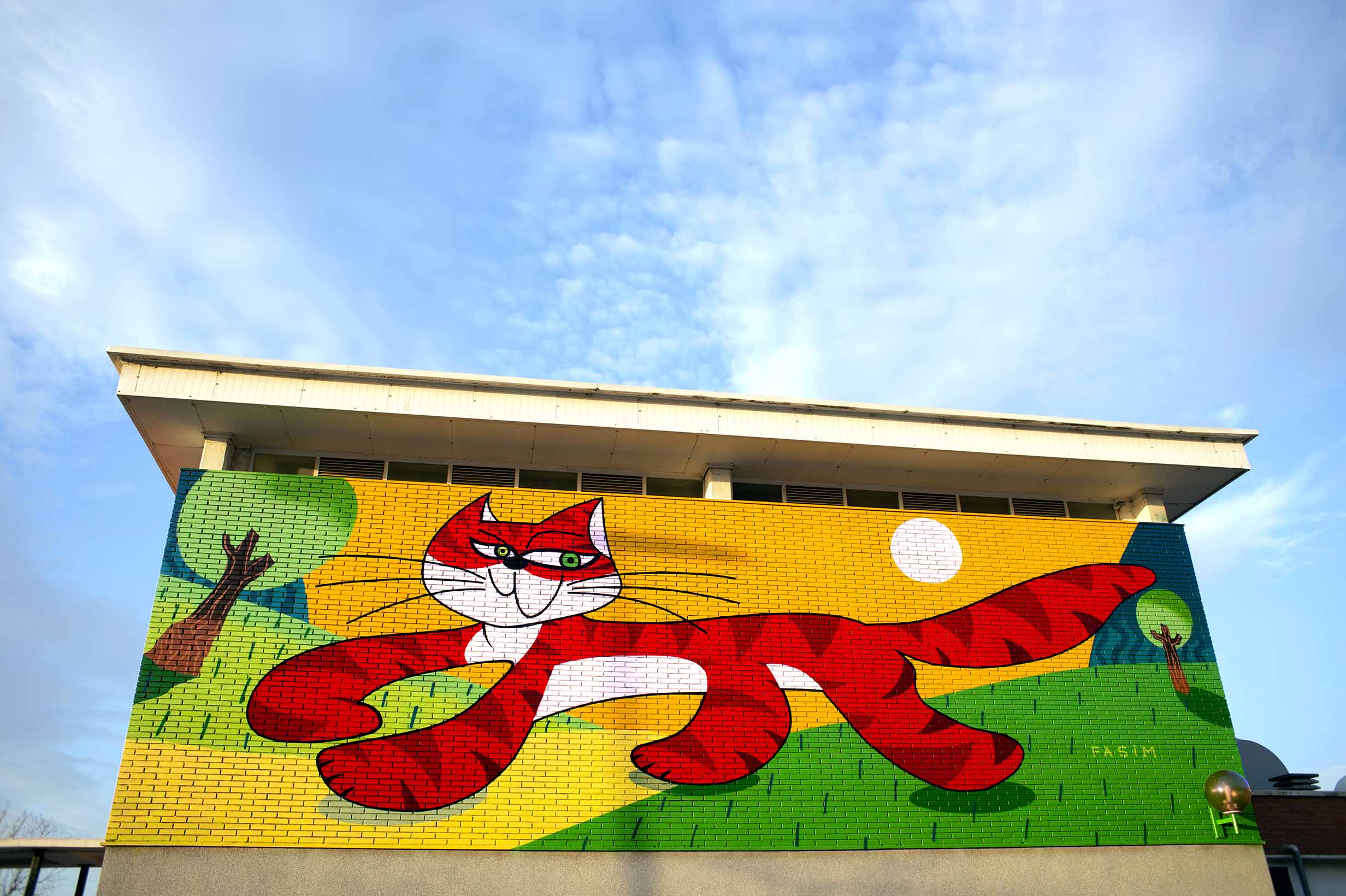
photo @pacopoyato
– How did it all start for you, and what is it nowadays?
It started as a game when I was a child, at the school stage and when I finished school I was already a well-known writer, I had progressed a lot and appeared regularly in the media and on television. Graffiti was the way to shout and rebel against everything and everyone, the way I chose to channel my rebellion and automatically identified myself with the writers of the poorest neighborhoods in New York who, like me, lived in peripheries. I immediately won over and I made IT my sword; “This is the creativity of young people under stress,” said Henry.
I was amazed by the battle that was taking place in the wagons of the New York City Metropolitan (in those days in its last stage), by then in Spain we did not have a complete knowledge of the game, but we were able to enlighten ourselves thanks to Craig Castleman’s book and the work of his students, the Nasty Stuff (originally titled) and the Getting Up in the final published version, and in a much more graphic and complete way with the documentary by Henry Chalfant and Toni Silver: Style Wars.
Today this game has become one of the favorite expressions of all young people worldwide and now you find graffiti in any corner of the planet, even in the smallest towns or villages, it has spread like wildfire, it is an escape route .
-Street art has had a great impact on society in recent years. Many artists manage to get in the spotlight and try to make a career out of it. What do you think of this evolution?
The movement started in the 90s has become from being an underground movement to be incorporated into a contemporary art and being absorbed by the financial market.
In my opinion, the period known as street art is over and we would be entering a new stage.
Throughout this period, a market that has not existed before has been created, the movement has become super professionalized, generating a great business that has attracted all kinds of creatives, enabling profesional meddlings us graphic designers, illustrators, comic artists, or even contemporary painters.
Street art has become a popular mass trend and a large percentage related to visual arts is adopting a street profile, many without having any relation to the street of course, it is just to maintain a pose and an aesthetic. Sometimes it is the same market which demands it (“we want a street touch”) or directly appropriates the pictorial techniques on walls by hyper-realistic painters at the service of commercial brands who try to appear a cool proximity to the Street; Anyway they usually not maintain the same feeling, someof them revindicate and remove consciences with their art but othersonly want to do business with unduly adopted aesthetics (something similar has happened with Mexican indigenous art; Carolina Herrera fashion firm is accused of plagiarism and cultural appropriation, it is a looting in every rule that has ended in the courts, but the most interesting thing in history is that Mexican artisans have not revealed the meaning of their elaborate garments, such is the cosmogony, because they ensure that each thread tells a story).
Represent the failure of success.
Urban art did not arise to decorate the streets and buildings at the service of capital, it is a combative art, it has a social meaning.
They are perfectly aware on fairs and galleries the wear and tear; For example, Tina Ziegler, curator and director of the Moniker fair, recently said on ArtNews “Street art is going through an “identity crisis.” Also in the same interview conducted by Naomi Rea, it is commented “local governments throughout the world are increasingly integrating mural projects in their cities as a way to deter illegal graffiti. ”
Although Street Art has had a great impact on society, museums and the establishment still consider it a marginal art, they continue to relate it to vandalism and are not taking the place that they should in museums, there is a strong reluctance.
Some street creators have noticed and they are adopting a more commercial and institutionalized style, if wanting to get rid of the vandalism label (when they never were, but the system perceives it that way). It is a great contradiction, you can not tame the movement, we are not the hippie movement that managed to dissolve it, it is much more complex. The system loves urban culture, but not urban artists who stand up from the crowd, prefer more commercial artists, without judgment
On the other hand in Spain a very negative elite image has been promoted by a small group of illustrators and pseudo artists, producers without many scruples, galleries, institutions, magazines and an audience that is not very uninformed. They systematically applauded, something that has been very damaging for the rest of the scene because they have acted as a monopolizing screen and such strategies. They will give a lot of money to a few, but they do a lot of damage and send the wrong message to the younger generations.
Although we are presented with makeup as the new, the latest, the digital, the modern against the old … But in reality, the old is the same concept again, always under the prefix of neo, neo-something … It is super dynamited, It is pure pyrotechnics.
Discussions have also been opened in networks and in the press about the gentrification factor that will generate this type of operations.
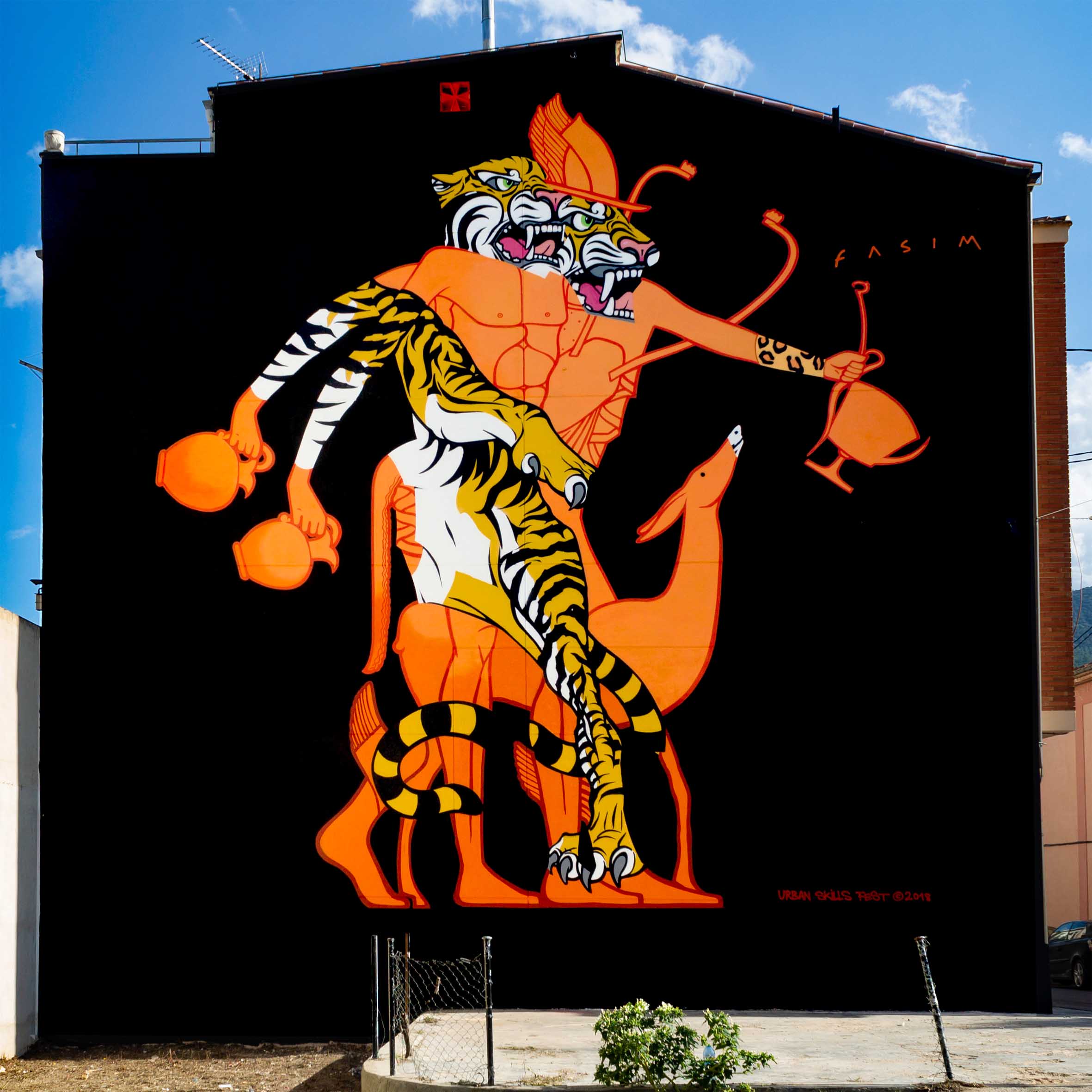
photo @jes_orquadi
-Street art is mostly a visually stimulating form of art. To add one more sense to it, what music would you pick to accompany your art work?
This album could be the soundtrack of some of my recent paintings; Ethnic Heritage Ensemble – Be Known – Ancient / Future / Music.
-In all forms of art, inspiration is crucial. What inspires you and how does that end up in your art?
Everything I see; some peeling paint on a wall, a spontaneous combination of colors in a group of half-torn posters, a chair that I have used as a color palette and is now my model (laughs), ancient art, attic craters, architecture and sculpture Egyptian, Baltasar Gracian, the island of Elephantine with its pareidolic forms of elephants which in the pharaonic era already aroused sacred admiration, The Island Shrimp, Baudelaire, LM Panero … Even the corrupt neo-liberal politicians to whom I have a series dedicated.
For some years I have been greatly inspired by deteriorated or destroyed art; the sculptures that have been brutally damaged in the face or in the body, suggest me metaphorical aspects of ourselves, of humanity, a kind of matter between creation and destruction, which seem to define us cryptically … Also the murals damaged by the passage of time that are incomplete and give way to another type of fragmented language, a very suggestive poetic visual game.
-What is the hardest part while working on a piece of art?
I think the judgement day is what decides everything. Sometimes one paints something at night very proud, he goes to sleep and the next morning when he sees it again it does not work. From my point of view that is the most delicate part, deciding if it works, but I insist again, many works remain on hold for an indefinite time and one day I finish them with spontaneous resolution. When I cannot look away from the work, it means that I liked it and I have to admit that it is good. I have a very special relationship with the work for a few days once finished, as a romance …
It is difficult to tell, but that is when I know that the work is fine, when I can not look away and the winding happens to me when I am immersed In a new one. I like to be fair with this, I try not to show anything I’m not really proud of. Some works arise in a few hours, others need a couple of days, others resist until years later and some need to disappear for the sake of one’s reputation (laughs). When the thing has gone well and good pictures come out it is a huge joy, I get very happy, I feel useful.
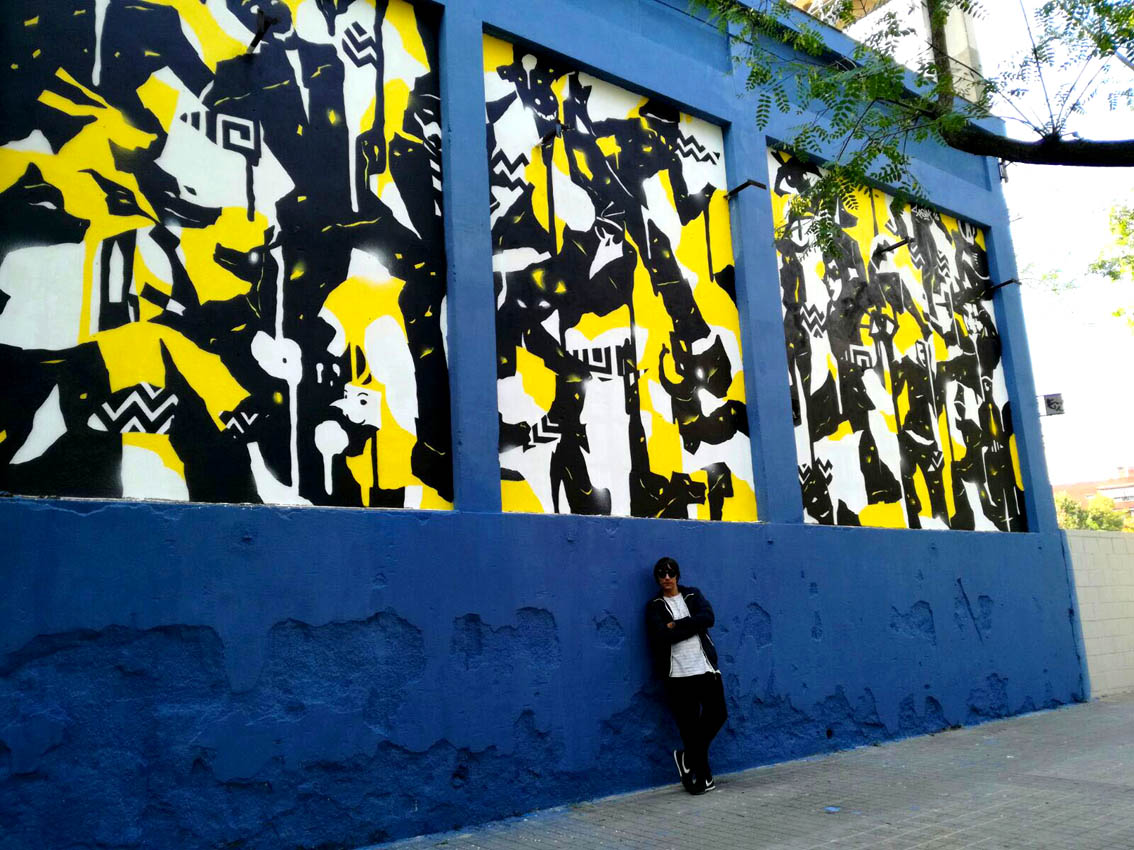
photo Marta Ballesta
-Which cities are the most inspiring for you as an artist?
– Barcelona and París.
-What other passions do you have apart from art?
I think all my passions revolve around art; painting, sculpture, music, literature, poetry, history, archeology, theater, photography, cinema, astronomy … Maybe the gastronomy, but I include it in the previous list for being the mother of the arts and melting pot of all civilizations.
-Tell us a bit more about your art; does it include symbolisms, messages or repeated patterns? How has it evolved?
I like each painting it be new adventure, a new chapter. I do not repeat symbols to be recognized by them, it makes me angry to see the same picture of an artist in different places.
In my work I insist on some subjects; heads or portraits, figures and landscapes, but especially landscapes. Also some personal archetypes.
I insist with some colors; yellow, black and white, but many times I do not realize, some color combinations are from when I started and I did not have much money to buy paint, I had to engineer them with few means (although that also put me to the test), I thought that, if I was not able to create works with one, two or three colors I was not a very good painter (laughs), an exercise that has become customary I suppose, although I have many colors in the workshop.
For me, each painting has the possibility of reflecting the mystery of everything I perceive intuitively and poetically, something like that is what I try.
– You must have a great collection of stories during street painting over the years, isn’t it? Could you share one of them with us?
I have many good memories with some of the best artists of the movement, but I have one burned in my memories. it was 1992, in the district of Saint Denis in Paris, in the studio of Jonone and the BadBC, the Hôpital éphémère, was sleeping a few days on the old sofa bed in the workshop and one night Jon was showing me a beautiful large oval fabric that they had returned from a painting contest and I remember seeing him very sad for not being able to participate in the exhibition, in those days urban art was still very badly considered and we were not well received by institutions or galleries and generally everything related to graffiti created an automatic rejection.
Jon was the one who really started me in painting, at that early time I was very interested in graffiti, you know, I had hot blood, I talked to him about writers and pieces, but he told me about painters and paintings. He taught me at home books by Jean-Michel Basquiat and Rammellzee, by Miquel Barceló … Artists that I did not know yet.
It was a voyage of discovery, literally I plunged deeply, something very powerful had awakened inside me.
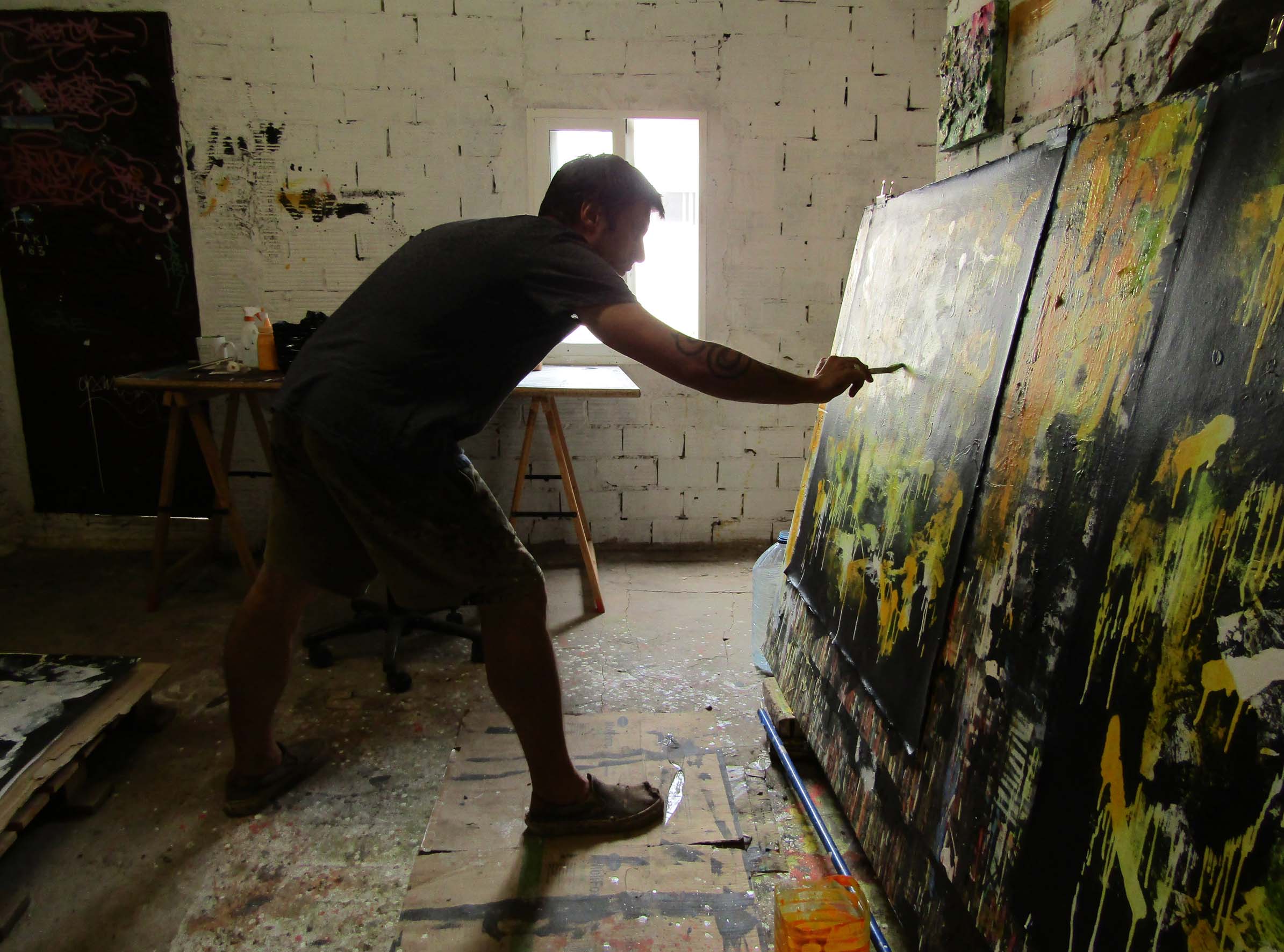
-What do you think, people feel or think of, when they see one of your works on the street?
I do not know, I hope most of the people receive positive feelings of good energy, although there are also some people who feel annoyed to see my work. My painting is different, the intention is not to be understood by everyone; “For those who understand us enslave a part of our being,” as Khalil Gilbran said.
I do not want to please everybody. I paint because I want to share something that worries me and I feel the urge to externalize it and share with the world, in my own way.
I intend to communicate with the bulk of the world population, connect with the sensitive world, with people who appreciate and protect art, poetry, music, nature and animals … It is not for those who throw bombs, make wars or they burn the Amazon, but also, sometimes I wish I could change consciences with my art, although it seems impossible or may seem a little innocent, but you never know, one can be struck by a transmutator ray at any time, also looking at a painting.
In front of paintings by master Joan Miró I decided to become a painter, it happens constantly.
-Nowadays, most artists also tend to think about how a wall will impact people through the internet. How do you feel about the use of social media in this field? Is a part of the essence missing?
Social networks are very good to publicize your work, but it should not condition your creativity, I explain; in painting, one must be honest with oneself, paint according to their criteria and not influenced by a tendency, fashion or number of likes. It is my way of seeing things, if today it is a tendency to paint flamingos I am aware that if I included them in my work my popularity would increase in networks and maybe sales would also increase or festival invitations would multiply, but I began to paint for others motives
“The painting is not made to decorate apartments. It is an instrument of offensive and defensive war against the enemy, ”said Picasso.
I have seen painters on Instagram that interest me very much and that have very few likes, does not determine anything, a work cannot be valued for the number of likes.
Painting is a rare and mysterious art; the good painting is deep … dark, the public likes less, however the most obvious, circus or effective painting generates greater acceptance, it has always been this way, although later it is valued late and it ends up recognizing what was previously despised, such as case of Manet or Van Gogh, to give two very practical examples.
The uninitiated in painting must learn to look, to see, to educate the look (as Soledad Lorenzo * says wisely). No criterion has been lost among the population, it is that the population does not have a great criterion formed on art, it is a pending subject. Today the obvious predominates, an institutionalized art style prevails that does not require a great effort of understanding and that pleases all audiences, such as the Balloon Dog by Jeff Koons.
For me the essence is still intact in the graffiti that is still being done on the trains, still alive in that spirit and in artists who continue to do their thing illegally without caring too much if their work is cool enough to appear in the magazine X or to enter the gallery Z.
-Do you have a secret that you would like to share with us?
I am going to tell you an anecdote that I have never told and it seems fun to do it here; once in the 90s we traveled Monica C. and I to the Salvador Dalí Museum in Figueres, from the early morning, we had previously taken acid, very well dressed and dressed in black sunglasses we went hand in hand in the museum as a couple of children entering Alicia’s burrow. It was one of the most amazing and mystical experiences I have had inside a museum, we were about six hours inside, we had traveled to the very bowels of surrealism. When we left it was already night … one of the favorite places of the day was the patio with the rainy Taxi (which is the central element of the old armchair patio of the Municipal Theater of Figueres). Also in the same space we were enchanted by the forms of the rocks of Antoni Pitxot in collaboration with Dalí (the four “grotesque monsters”). They are monsters-fountains in the manner of Italian mannerists, made with accumulations of stones, drawers, tree trunks, a skeleton of a whale, conch shells and shells.
One thing we found really surreal was that the sink was next to the door that leads to Salvador Dalí’s grave. You get distracted, you are wrong about the door and you end up inside the crypt, we loved those details, we valued them a lot (laughs), the same bill as the source of Marcel Duchamp.
Dalí said that the rocks of the beach of Sa Conca in Cadaqués already formed by themselves multiple battles: “When the rocks awake for four thousand years of dreaming, the noise of a battle in each hand deafens them.”
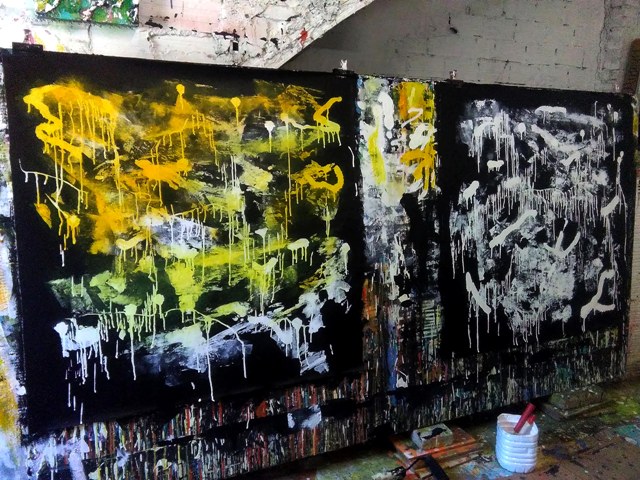
-Do you have a wild project that you dream of doing someday?
Exhibit at the Jau de Paume in Paris!
-Tell us what’s next, about your future plans!
My plan is always to lock myself in the workshop (laughs). It’s my refuge, that’s where I want to be all the time, like Rembrandt. I have finished some things that I had pending and I am heading towards a new collection of paintings with a technique close to cut-up, also to collage, the style of the exquisite corpse, images of everyday use, also with mixed mythological themes or anything that falls into my hand. I had already started last year and I have not been able to develop it well. Also in the IVAM (Valencian Institute of Modern Art) of Alcoy I made my first public conference at the end of last October, where I related some curiosities of graffiti and inscriptions in the ancient world and some more of how we started in painting since the paleolithic going through Egypt, Greece and Rome. I am very happy because I shared a conference with Fernando Figueroa, a well-known writer on the graffiti and urban art movement in Spain who recently wrote the prologue for the new edition of the historic book Getting Up by Craig Castleman and that encouraged me very much to prepare it with great desire .
-Is there a specific thought or message you would like to pass to our audience out there?
I am the king of my shoes.
Cultures unite us, flags face us…
– Thank you Fasim! It’s been great to get to know more about the mind and person behind such inspiring works.
‘’I Support Street Art’’ team.
Thank you for the opportunity to express myself and share my art in your home.
All the best family, you do a great job.
“Yo apoyo el arte callejero”.
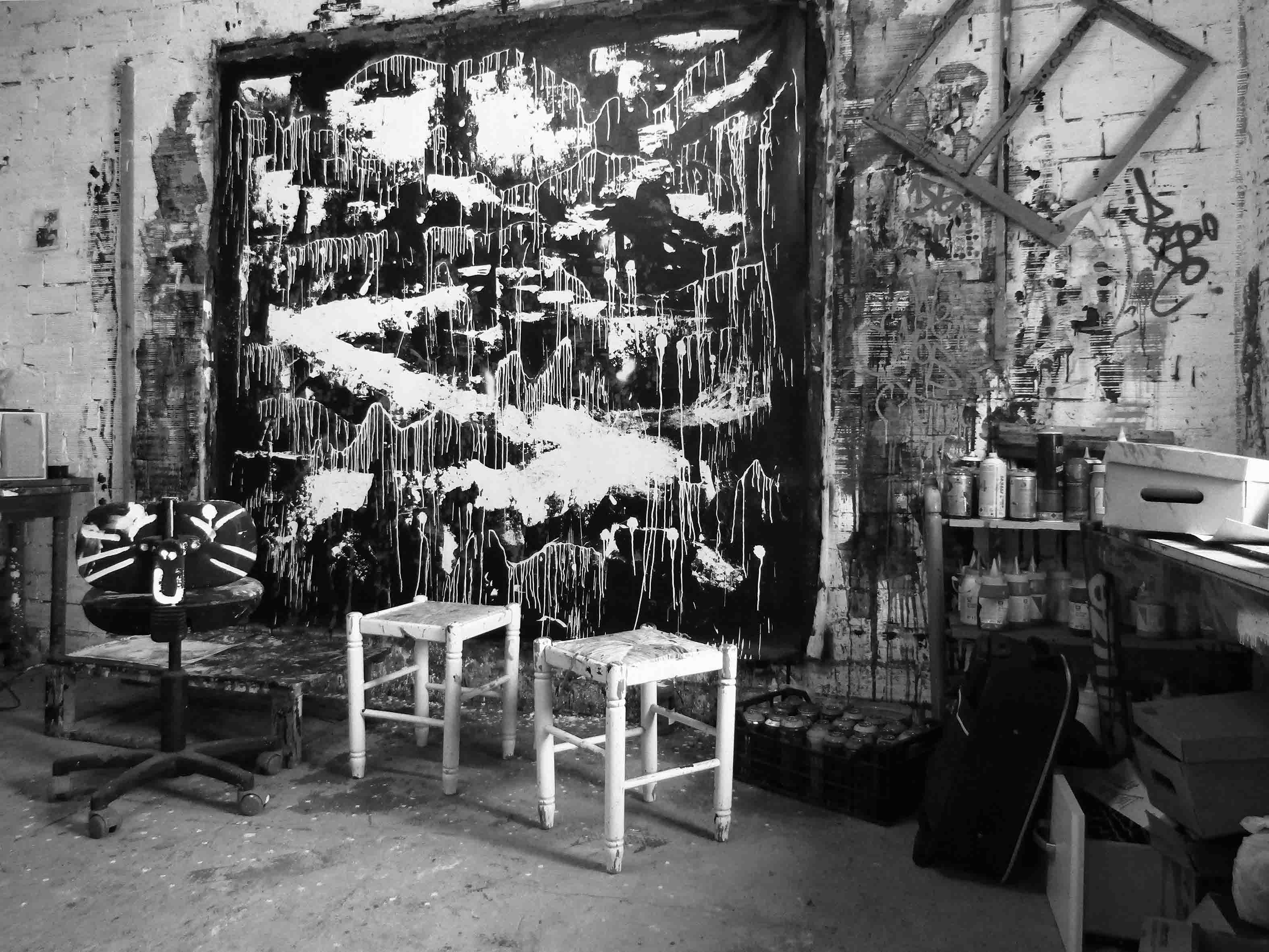
Artist Links: FASIM
leave your comment